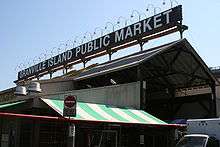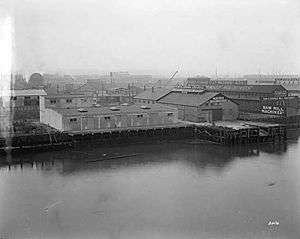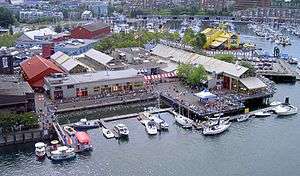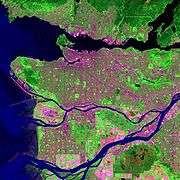Granville Island
| [[|Native name]]: Snauq | |
|---|---|
|
Northwest Granville Island in 2005. The large complex in the centre is the public market. | |
_Downtown_-_OpenStreetMap.png) Granville At South edge of Downtown Vancouver | |
| Geography | |
| Location | Vancouver |
| Coordinates | 49°16′15″N 123°08′03″W / 49.27083°N 123.13417°WCoordinates: 49°16′15″N 123°08′03″W / 49.27083°N 123.13417°W |
| Archipelago | peninsula |
| Adjacent bodies of water | False Creek |
| Area | 14 ha (35 acres) |
| Administration | |
|
Canada | |
| Additional information | |
| Official website |
granvilleisland |
Granville Island is a peninsula and shopping district in Vancouver, British Columbia, Canada. It is located across False Creek from Downtown Vancouver, under the south end of the Granville Street Bridge. The peninsula was once an industrial manufacturing area, but today it is now a hotspot for Vancouver tourism and entertainment. The area has received much acclaim in recent years for its buildings and shopping experience. The area was named after Granville Leveson-Gower, 2nd Earl Granville.
The island is home to 275 businesses and facilities that employ more than 2,500 people and generates more than $215-million in economic activity each year.[1]
Granville Island provides amenities such as a large public market, an extensive marina, a boutique hotel, the Emily Carr University of Art and Design (named in honour of the artist), Arts Umbrella, False Creek Community Centre, various performing arts theatres including Vancouver's only professional improvisational theatre company Vancouver Theatresports League, the Arts Club Theatre Company and Carousel Theatre, fine arts galleries, and variety of shopping areas.


The Granville Island Public Market features a farmers' market, day vendors, and artists offering local Vancouver goods. There are 50 permanent retailers and over one-hundred day vendors in stalls throughout the market selling a variety of artisan cottage-industry foods and handmade crafts on a rotating schedule.[2]
Granville Island Brewing Co. is also the name of a beer company which originated on Granville Island in 1984, but whose main base of operations was moved to Kelowna, British Columbia some time later. In 2009 it was purchased by Molson's Brewery and continues to brew small batches of its varieties at the Granville Island brewing original site, and offers beer tasting and tours of their brewing facilities.
Ocean Concrete is the longest-established tenant on the island, having set up shop there in 1917.[1]
Granville Island is the central location of several annual Festivals, including the Vancouver International Children's Festival, the Vancouver Fringe Festival, and the Vancouver Writers Fest.
Transportation
Two companies, False Creek Ferries and Aquabus, provide ferry service from Granville Island to Downtown Vancouver including numerous stops in Yaletown, Downtown South/False Creek, and the West End as well as Vanier Park near Kitsilano Beach. Other water transportation options include a taxi service to Bowen Island provided by English Bay Launch and a number of private tours.
There is also a streetcar route operated by the Vancouver Downtown Historic Railway. During the 2010 Winter Olympics, a free service was offered between Granville Island and SkyTrain's Olympic Village in the SE False Creek neighbourhood. The city is planning to extend this route to SkyTrain's Main Street-Science World station and then eventually to Chinatown, through the historic and Financial districts, to terminate in the Coal Harbour neighbourhood near Stanley Park. This streetcar is now permanently shut down.
History
The peninsula was originally used by First Nations as a fishing area.

The city of Vancouver was called Granville until it was renamed in 1886, but the former name was kept and given to Granville Street, which spanned the small inlet known as False Creek. False Creek in the late 19th century was more than twice today's size, and its tidal flats included a large permanent sandbar over which spanned the original, rickety, wooden Granville Street bridge. This sandbar, which would eventually become Granville Island, was first mapped by Captain George Henry Richards in the British Boundary Commission's naval expedition in 1858-59, and the island today conforms roughly to the size and shape documented at that time.[3] A British Admiralty Chart of 1893 shows the island in greater detail and conforming even more accurately to today's Granville Island.[4]
The first attempt to stabilize the sandbar by driving piles around the perimeter was an unofficial attempt to create some free real estate shortly after the creation of the original Granville Street bridge in 1889. The Federal government put a stop to the work as a menace to navigation, but the piles are still visible in a photo taken in 1891.[4]
In 1915, with the port of Vancouver growing, the newly formed Vancouver Harbour Commission approved a reclamation project in False Creek for an industrial area. A 14-hectare (35-acre) island, connected to the mainland by a combined road and rail bridge at its south end, was to be built. Almost 760,000 cubic metres (1,000,000 cu yd) of fill was dredged largely by a man named Alvin Kingston, from the surrounding waters of False Creek to create the island under the Granville Street Bridge. The total cost for the reclamation was $342,000. It was originally called Industrial Island, but Granville Island, named after the bridge that ran directly overhead, was the name that stuck.
The very first tenant, B.C. Equipment Ltd., set the standard by building a wood-framed machine shop, clad on all sides in corrugated tin, at the Island's western end. (Today the same structure houses part of the Granville Island Public Market.) The company repaired and assembled heavy equipment for mining and forestry industries and used barges for shipping.
By 1923 virtually every lot on the Island was occupied, mostly by similar corrugated-tin factories.
During the Great Depression, one of Vancouver's several hobo jungles sprang up on the False Creek flats opposite Granville Island's north shore.[5] "Shackers" lived on the island, in town, or in floathouses, and survived by fishing and beachcombing and sold salmon, smelt, and wood door to door or at the public market on Main Street.[6] They were basically self-sufficient and were left alone.
During the Second World War, Wright's Canadian Ropes on the island was Canada's biggest manufacturer of heavy-duty wire rope. Their Green Heart product was supplied to forestry and mining industries. A fire in 1953 gutted their Granville Island factory so they moved to south Vancouver in 1956.

In 1972, a federal order-in-council assigned management of the 14-hectare site to Canada Mortgage and Housing Corporation (CMHC).[1] The federal government invested $24.7 million there between 1973 and 1982.[1] In 1979, the federal and provincial governments converted a 50,000 square foot building to the Public Market. In 1980, the Emily Carr University of Art & Design was added to the island.
Ron Basford, the Minister responsible for CMHC was, was referred to as Mr. Granville and was later recognized with the naming of Ron Basford Park on Granville Island.
In 2016, the federal government announced a commitment to develop a 2040 plan to redevelop the island, in part because the Emily Carr University was going to move off the island.[7][8]
References
- 1 2 3 4 Stueck, Wendy (2014-12-30). "Beloved Granville Island a landmark in transition". Globe & Mail. Retrieved 7 May 2016.
- ↑ Granville Island | Day Vendors Association. Gidva.org. Retrieved on 2014-04-12.
- ↑ Hayes, Derek. "Historical Atlas of Vancouver and the Lower Fraser Valley False", 2005. p. 30.
- 1 2 Hayes, Derek. "Historical Atlas of Vancouver and the Lower Fraser Valley False", 2005. p. 104.
- ↑ Roddan, Andrew; Todd McCallum (2005) [1931]. Vancouver's Hoboes [God in the Jungles]. Vancouver: Subway Books. pp. ii–iii, 83–84. ISBN 0-9687163-9-3.
- ↑ Wade, Jill (1 March 1997). "Home or Homelessness? Marginal housing in Vancouver, 1886-1950". Urban History Review (25): 19–29. Retrieved 2007-02-04.
- ↑ Howell, Mike (2016-05-06). "Feds launch plan to re-imagine Granville Island in 2040 : Revitalization of the public market among potential changes". Vancouver Courier.
- ↑ Bramham, Daphne (2016-05-06). "A 'jewel' in need of polishing, Granville Island gets some needed attention". Vancouver SunA.
External links
| Wikivoyage has a travel guide for Kitsilano & Granville Island. |
| Wikimedia Commons has media related to Granville Island. |
- Official Granville Island website
- Granville Island Cultural Society Information about busking (street performing) on Granville Island and theatre information
- Satellite image of Granville Island from Google maps.
- Granville Island Day Vendors Association website
- Granville Island Business and Community Association website
- Granville Island Works community website
- The Growing Pains of Vancouver - Internet radio documentary discussing Granville Island from 24'00" till 34'43".

